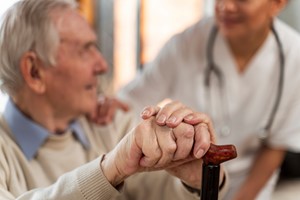This study examines the impact of mutual care on the physical and mental health of rural elderly individuals and offers suggestions for the long-term development of mutual care in rural areas. Data from the 2018 China Health and Retirement Longitudinal Study (CHARLS) were analyzed, involving 8,369 elderly individuals aged 60 and older. Various matching methods, such as nearest-neighbor matching, kernel matching, and radius matching, were used to control for confounding factors. Furthermore, heterogeneity analysis was applied to investigate the effects across different populations.
The results from propensity score matching (PSM) indicated that participation in mutual care had a significant positive effect on the mental health of rural elderly individuals, with a net effect ranging from 0.020 to 0.027. In contrast, participation in mutual care had a significant negative effect on physical health, with a net effect between −0.029 and −0.030.
Additionally, heterogeneity analysis revealed that mutual care did not significantly affect the physical and mental health of rural elderly individuals without chronic diseases. For those without chronic conditions, the net effect on physical health ranged from −0.06031 to −0.035, and the effect on mental health ranged from 0.029 to 0.030.
Despite these findings, it is worth noting that the rate of mutual care participation among rural elderly is relatively low. The study found that only 35.55% of rural elderly individuals were involved in mutual care, with 64.45% not participating in such activities.
Furthermore, the influence of mutual care on physical and mental health varied across different subgroups of the rural elderly population. Characteristics such as age, marital status, and chronic disease presence affected the degree of impact on health outcomes.
To investigate the mental health impacts of mutual care participation, logistic regression analysis was conducted with depression as the dependent variable and participation in mutual care as the independent variable. The results revealed that mutual care participation positively influenced mental health outcomes, reducing depression among rural elderly participants (P < 0.05).
Additionally, other factors such as age, pension, alcohol consumption, and religious beliefs were found to have a negative effect on mental health, while chronic diseases, marital status, and gender had a positive effect on mental health.
In terms of physical health, logistic regression analysis was used with the impairment of activities of daily living (ADL) as the dependent variable. The results showed that participation in mutual care had a negative impact on physical health impairment. Other factors, such as health insurance, pension, and alcohol consumption, were positively associated with better physical health outcomes, while age, chronic disease, marital status, and gender were negatively associated with physical health impairment among rural elderly individuals.
A common support test was conducted to evaluate the matching quality of the sample data. This test ensures that the treatment and control groups are comparable, minimizing sample loss and enhancing the validity of the analysis.
The kernel density functions of the treatment and control groups were compared before and after matching. Prior to matching, there was a significant difference between the two groups. However, after matching, the observed values of the treatment and control groups overlapped significantly, confirming that the matching effect was ideal, and the common support assumption was satisfied.
The study highlights the relatively low participation rate of rural elderly in mutual care, despite its positive effects on mental health. While mutual care appears to have a detrimental impact on physical health, especially for those with chronic diseases, the results emphasize the need for targeted interventions that address the unique characteristics of rural elderly populations.
The findings suggest that improving access to mutual care programs and tailoring them to the specific needs of different subgroups could have significant implications for the long-term development of mutual care in rural areas. Further research should focus on understanding the underlying mechanisms and exploring strategies to enhance physical health outcomes for elderly participants in mutual care programs.










